Disclaimer: This post may contain affiliate links which means I may receive a small commission from purchases made through links. However, these are products that I would wholeheartedly recommend to my family and friends regardless if I make a small commission at no cost to you as a consumer.
Introduction
If you are a fan of hot pot and want to enjoy it at home, you’ve come to the right place. In this ultimate guide to hot pot at home, we will provide you with all the information you need to create a delicious and authentic hot pot experience in the comfort of your own home.
Most of the hard work for enjoying hot pot at home goes into the preparation of the soup base and ingredients. We will show you the traditional way it’s normally done, but most importantly, we will also provide tips on what to buy from the grocery store to cut down most of that work!
Hot pot has become a popular meal for friends and family to share. When hosting a hot pot party, make sure to provide plenty of broth, meats, seafood, vegetables, and sauces for your guests. For added convenience, some hosts also prepare their own hotpot condiment platter with an array of dipping sauces such as chili oil, sesame oil, soy sauce, and vinegar.
What is Hot Pot?
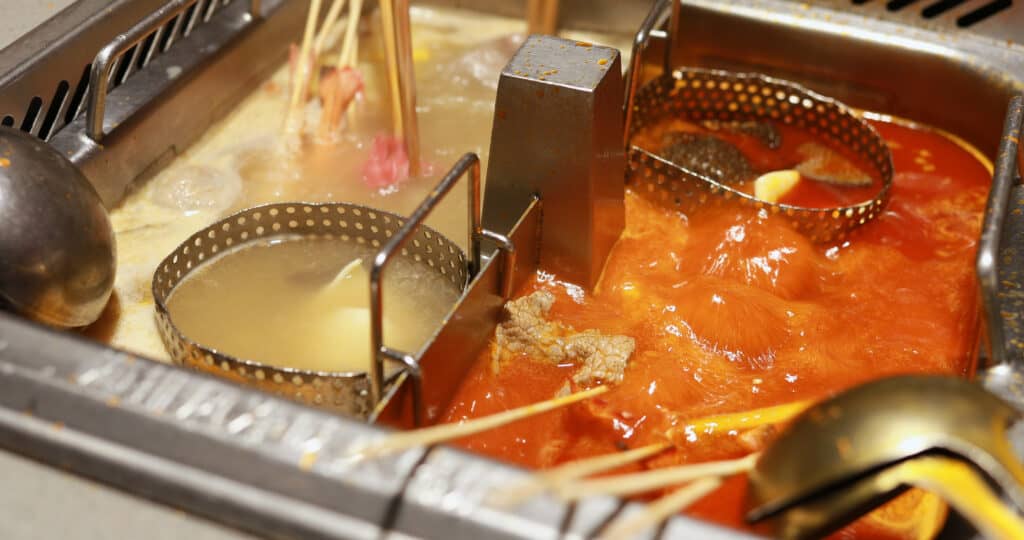
Hot pot is a popular Chinese cooking method where a simmering pot of broth is placed in the center of the dining table, and diners cook their own meats, seafood, and vegetables in the broth. The cooked ingredients are then dipped in a variety of sauces before eating.
The fun part of hot pot is that everyone’s a cook since they pick what they wanted to eat, and how much, then cook their own food to their liking. It’s also a great way to get everyone involved in the cooking process, so everyone can enjoy the experience together! Plus, it leads to new and exciting flavor combinations that you might not have thought of before.
Many Asian countries have their own version of hot pot, such as Japan’s Sukiyaki or Shabu-Shabu, and the Korean version usually involves hot pot with BBQ.
Hot pot is a great way to enjoy many different types of ingredients at once. The key to making a delicious hot pot is cooking the ingredients in a flavorful broth – this will bring out their natural flavors and make for an unforgettable meal.
The History of Hot Pot
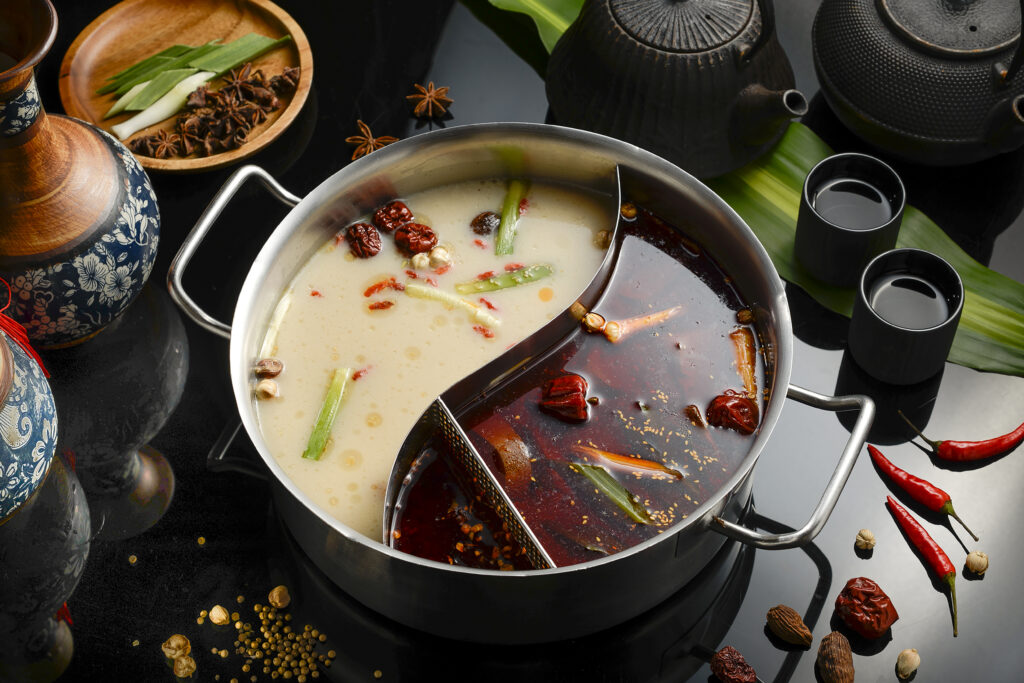
Hot pot has a long history that can be traced back to the Tang dynasty (618-907 AD) in China. It was originally created as a way for the poor to stretch their ingredients by cooking them in a communal pot with inexpensive cuts of meat.
Over the centuries, it has become a popular family-style meal in China and other parts of East Asia.
Hot pot is also very popular in Japan, where it is known as “nabemono” or “one-pot cooking”. In Japan, hot pot dishes often include ingredients like beef, chicken, seafood, tofu, mushrooms, and vegetables. The broth is usually flavored with soy sauce, sake, miso, or other seasonings. Hot pot in Japan is often served with a variety of dipping sauces on the side.
In Korea, hot pot is usually known as “jjigae” or “stew”. Jjigae typically contains beef, pork, or seafood and is usually heavily seasoned with gochujang (Korean chili paste) and kimchi. In addition to the main ingredients, jjigae often contains a variety of vegetables like potatoes, onions, mushrooms, and zucchini.
Hot pot has become increasingly popular outside of East Asia as well. In the United States, hot pot dishes can be found in many Chinese and Vietnamese restaurants. These hot pot dishes are often served with a variety of dipping sauces and condiments like fish sauce or chili oil.
No matter where it’s enjoyed, hot pot is an amazing way to experience different flavors and textures. Whether you’re making Japanese shabu-shabu, Chinese hot pot, or Korean jjigae, there’s something for everyone at the dinner table. So why not give it a try and see what you think? You won’t regret it! Happy cooking!
Benefits of Making Hot Pot at Home
1. Budget-friendly
To enjoy this interactive dining experience does not always means you have to make a reservation at hot pot restaurants. In fact, if you have quite a few people in your group, a meal at a hot pot restaurant could be costly.
While restaurant hot pot experiences can be pricey, making hot pot at home can be quite cost-effective. You can choose ingredients within your budget, and often, a little goes a long way in a hot pot.
2. Time Flexibility
It is a fun and interactive dining experience that can be enjoyed with family and friends in the comfort of your own home. There will be time before and after the meal for everyone to mingle and spend time with each other. Friends and family members can also bond over preparing the hot pot dinner.
Time usually is not as flexible if you are at a restaurant, especially if it’s a buffet style where dining time will be restricted to around 90 minutes.
3. Healthier Choices
Preparing hot pot at home allows for control over ingredients, ensuring you’re consuming fresh, nutrient-dense foods. You can opt for lean proteins, abundant vegetables, and broth with less sodium, leading to healthier meals.
It is also a healthy meal option as it typically includes a variety of fresh vegetables and lean meats. Unlike ordering a dinner plate where you choose an entrée and sides, you could have a full spectrum of ingredients all in one dinner, all different types of meat, veggies, seafood, etc. Talk about a balanced meal!
4. Customization
When making hot pot at home, you can adjust every element to your preference. From the broth’s flavor profile to the dipping sauce’s kick, everything can be tailored to your taste buds.
5. Fun
Everyone’s a cook! Since guests will be picking their own raw ingredients and cooking them themselves to their liking, they will like their food better. There’s a study that cited that if you are involved in the food preparation process, you will enjoy the food that much more. Isn’t that why we have our kids help make cookies in the kitchen??
Preparing for Hot Pot at Home
Before making hot pot at home, there are a few things to consider. First, you will need to choose the right hot pot equipment, including the pot, burner, and utensils. You will also need to select your ingredients and prepare the broth.
Choosing the Right Hot Pot Equipment: A Quick Checklist
Choosing the right hot pot equipment is an essential step in creating an authentic and enjoyable hot pot experience at home. There are several things to consider.
Investing in the right equipment will not only enrich your hot pot experience but also ensure it’s easy, safe, and delicious.
1. The Right Hot “Pot”
Traditional hot pots are dual-sided, allowing you to serve two different broths simultaneously for a versatile culinary adventure. It is very helpful if someone in your party doesn’t like spicy broth or has dietary needs like vegetarian.
Also, consider the size of the pot based on the number of people. It’s better to opt for a standard size as it can accommodate larger gatherings, yet it remains perfectly functional for an intimate meal for one or two, providing versatility for all your dining situations.
Lastly, consider the material of the pot. Stainless steel would be a safe bet since it could be used with both gas or induction cookers. Consider one with thinner material as it allows water to boil faster, leading to greater energy efficiency and quicker meal preparation.
We recommend the Yzakka Stainless Steel Hot Pot with Divider or the Aroma Stainless Steel Dual-Sided Hot Pot.
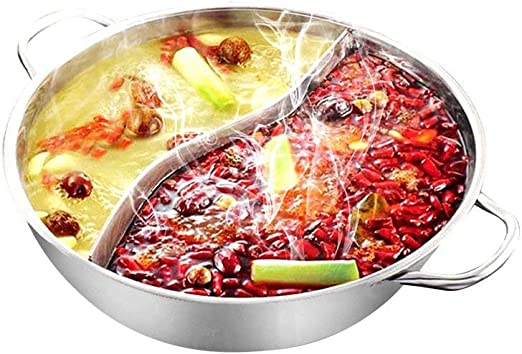
Yzakka Stainless Steel Hot Pot with Divider
This pot can accommodate two separate broth flavors and could be used with both gas or induction cookers. It’s made of stainless steel for durability and food safety. The depth is just right to hold enough food yet shallow enough to retrieve food safely.
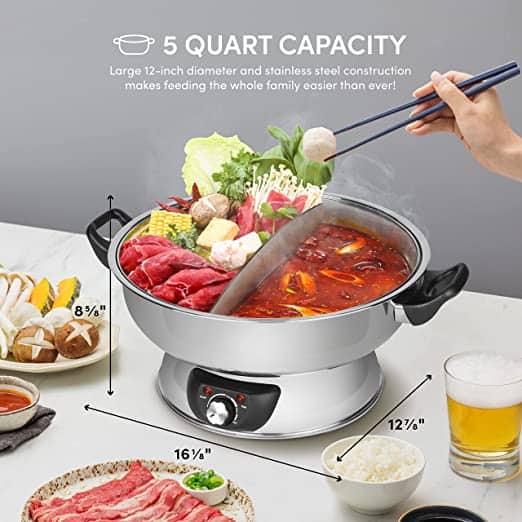
Aroma Stainless Steel Dual-Sided Hot Pot
This pot comes with a dual-sided pot and a hot plate with precise temperature control so you will not need a separate heat source. Stainless steel construction for durability and food safety. The depth is just right to hold enough food yet shallow enough to retrieve food safely.
2. Heat Source
A reliable heat source is crucial. Opt for a portable gas stove or an induction cooker to provide consistent and adjustable heat.
When choosing between a portable gas stove and an induction cooker for your hot pot experience, both come with distinct advantages and drawbacks.
Portable gas stove
A portable gas stove offers quick, high heat and precise temperature control. It doesn’t require a specific type of cookware, allowing you to use your existing pots.
It also doesn’t require any electricity to operate, meaning, no wire and cable dangling along the side of the table, making it safer if there are kids running around.
Keeping a portable gas stove on hand serves as an excellent backup plan, ensuring you can continue cooking your hot pot feast (or any other meal) even in the event of a power outage when your primary electric stovetop isn’t operable. It is also excellent on camping trips.
IMPORTANT SAFETY NOTE: Gas stoves necessitate proper ventilation due to carbon monoxide emissions, and they also require a continuous supply of gas.
One drawback of a gas stove is you will need to plan in advance to have enough cans of gas for the whole night of hot pot meal.
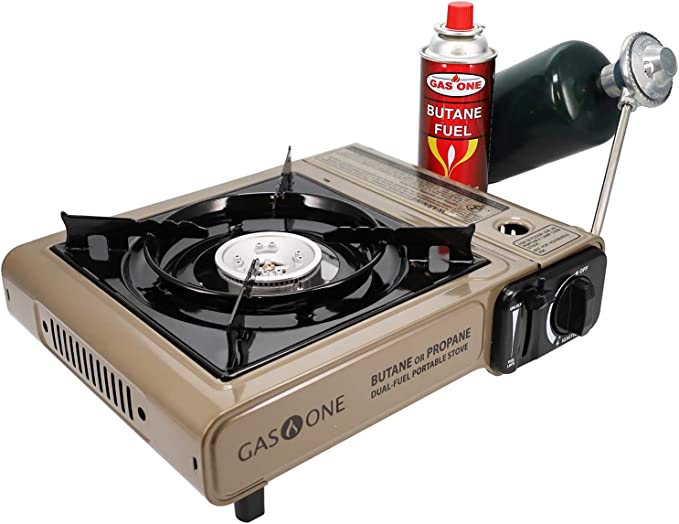
Gas One Propane or Butane Portable Gas Stove
High output of 8,000 BTU. Duel Fuel – Compatible with both butane and propane fuel. Safety Features – Built In pressure sensor cartridge ejection system and gas flow cut-off mechanism (butane), will eject the cartridge when irregular pressure is detected.
Portable induction cooktop
On the other hand, induction cookers are energy efficient, heating the pot directly, which reduces wasted heat and cooking time.
They’re safer because the surface doesn’t get hot unless it’s in contact with an induction-friendly pot. But, induction cookers require specific cookware made of a magnetic-based material, and they may not provide the same level of heat control as gas stoves.
IMPORTANT SAFETY NOTE: When using an induction cooker for hot pot, ensure to keep the power cord neatly tucked away, as a dangling wire can pose a tripping hazard, potentially leading to accidents.
Also, some people find the hum they generate during operation slightly annoying. It’s best to choose based on your personal needs and kitchen setup.
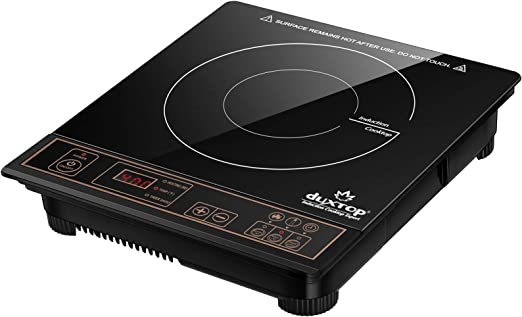
Duxtop Portable Induction Cooktop
This induction cooktop uses 120V 15 amp electrical outlet (standard in North American homes). Digital control panel with 10 temperature range from 140°F to 460°F; 10 power levels from 200 to 1800 Watts. With no open flame or heating element, food does not burn-on the glass cooktop so this induction burner is easy to clean.
3. Utensils
Utensils are equally important. Long-handled, strainer-style ladles are essential for cooking and retrieving ingredients from the pot safely.
And don’t forget about the serving bowls and dipping sauce dishes. Ceramic or porcelain options add an elegant touch and keep your sauces cool.
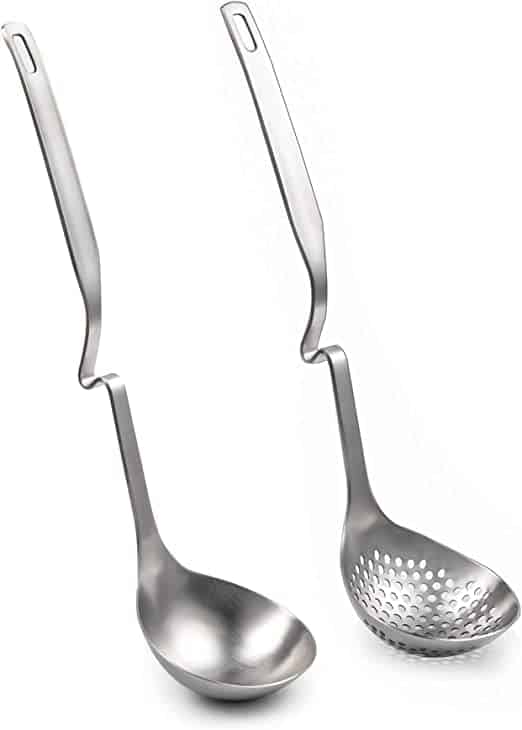
IMEEA Hot Pot Laddle Set, 12-inch
This set comes with food-grade SUS304 stainless steel ladle and slotted spoon. BPA-free and dishwasher-safe. The curved handles are fantastic for grabbing onto the edge of a pot or bowl, no more spoons slithering down into the soup and making a mess all over the stove or counter. one-piece seamless stainless steel design prevents build-ups of food and grime. Convenient hole in the handle for easy hanging and storage.
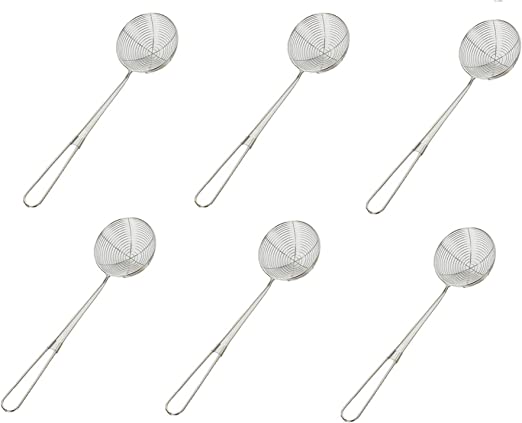
BRCCEE Hot Pot Strainer, Set of 6
This set comes with 6 pieces of stainless steel 11 inches long including the 2.5-inch diameter basket strainer. Each guest could have their own strainer as utensils so no need for sharing. Dishwasher-safe.
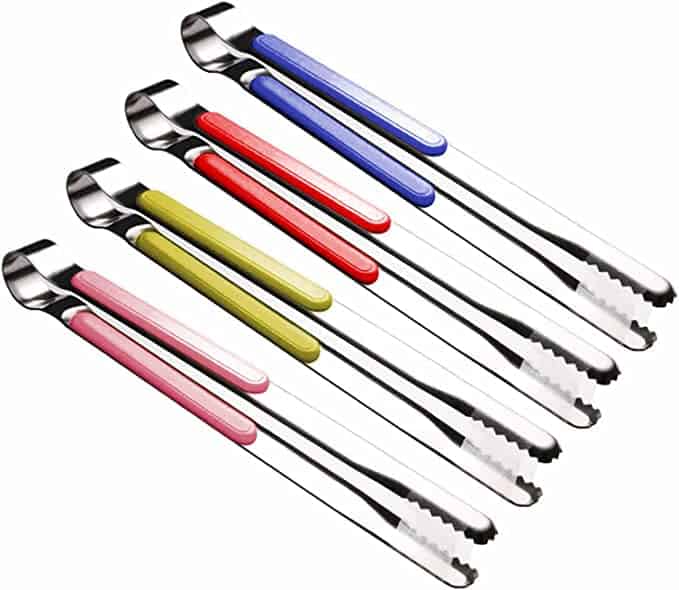
Stainless Steel Kitchen Tongs 10-Inch
Since hot pot usually involves raw meat and seafood, it’s best to have something that is dedicated to that purpose so that it will not cross-contaminate with other utensils.
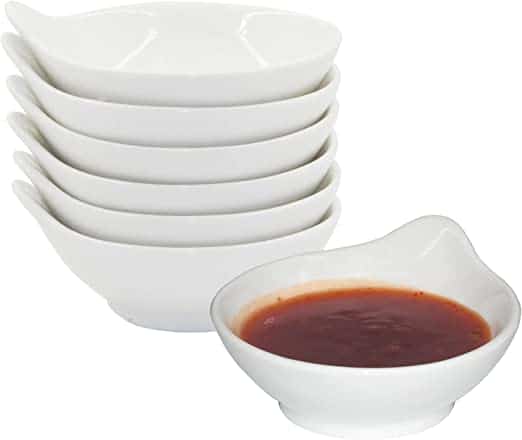
Porcelain 3-Ounce Sauce Dish, Set of 6
Each hot pot guest will need a sauce dish to mix their own sauce. This set of sauce dish comes with a handle for easy handling if it the dish is pretty full.
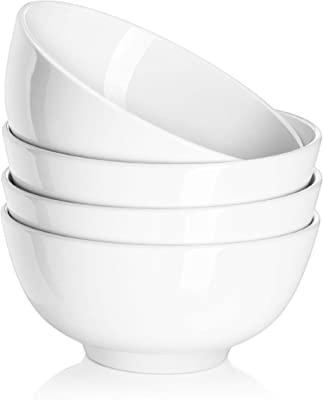
Dowan 6-Inch Ceramic Soup Bowl, Set of 4
Since the food will be very hot (usually consumed not long after it’s cooked in a hot pot of broth), the bowl used not only must be well constructed but also have some kind of feet. These footed soup bowls will make holding a hot bowl of soup possible and safe.
4. Nice to Have
Lastly, for a truly immersive experience, you might want to consider additional accessories such as a lazy Susan for easy access to ingredients and a protective shield to keep the splatter at bay.
Ingredients for Enjoying Hot Pot at Home
Here’s the fun part! The ingredients for a hot pot at home can vary depending on personal preference but typically include a variety of meats, seafood, vegetables, and noodles. We will provide you with a comprehensive list of ingredients to choose from and tips on how to prepare them.
1. Preparing the Hot Pot Broth
The broth is the foundation of the hot pot, and it is essential to get it right. We will provide you with several different broth recipes to choose from, including traditional Chinese hot pot broth, spicy Sichuan hot pot broth, and vegetarian hot pot broth.
A. Traditional Chinese Hot Pot Broth
Combine 2 pounds of chicken pieces (or chicken carcass), a few pieces of pork bones in a big stockpot, 2 liters of water, 3 slices of fresh ginger, 2 scallions cut into 2-inch pieces, and 1 tablespoon of Chinese cooking wine in a big stockpot. Bring the mixture to a boil over high heat. Reduce heat to low and let it simmer for 20-30 minutes to allow the flavors to meld. Strain the broth to remove the solids.
B. Spicy Sichuan hot pot broth
Combine 1 liter of beef broth in a big stockpot along with 3 tablespoons of Sichuan peppercorns, 4 dried red chilies, 2 slices of fresh ginger, 2 cloves of crushed garlic, 2 whole star anise, 1 tablespoon of soy sauce, 1 tablespoon of chili oil, salt to taste. Bring the mixture to a boil over high heat. Reduce heat to low and let it simmer for 20-30 minutes to allow the flavors to meld. Strain the broth to remove the solids.
C. Vegetarian hot pot broth
Combine 1 liter of vegetable stock in a big stockpot along with 3 slices of fresh ginger, 2 cloves of crushed garlic, 1 whole star anise, 1 tablespoon of soy sauce, and salt to taste. Bring the mixture to a boil over high heat. Reduce heat to low and let it simmer for 20 minutes to allow the flavors to meld. Strain the broth to remove the solids.
D. Bouillon-based stock
Bouillon powder or paste could be used in place of making stock from scratch. It could also be used to replace the homemade broth or stock in the above recipes.
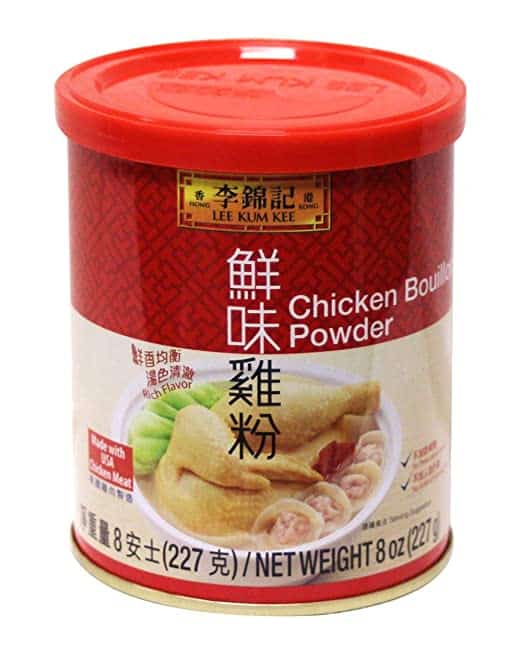
Lee Kum Kee Chicken Bouillon Powder
Lee Kum Kee is a well-known and well-respected brand in the Asian sauces market with a wide range of products to choose from.
This is a super shortcut if you don’t have time to make a full-blown broth for a broth of soup base. It is easy to use and the flavor is easy to adjust.
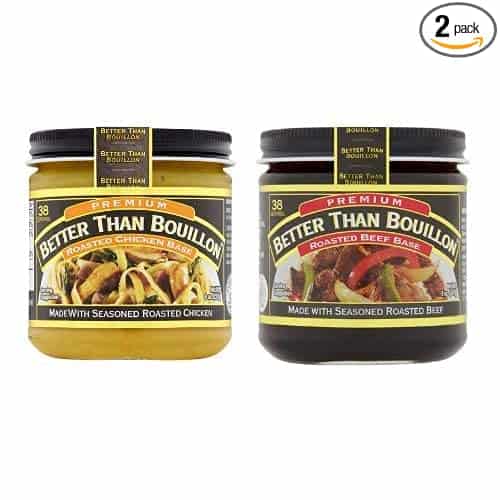
Better Than Bouillon Premium Bouillon Paste
Most American households will have this in their arsenal. The Better Than Bouillon brand offers a variety of bouillon paste flavors like chicken, beef, garlic, etc. It is easily accessible in most supermarkets and grocery stores.
Just take a big spoonful of the paste and melt it in hot water to create a stock. This is a super shortcut if you don’t have time to make a full-blown broth for a broth of soup base. It is easy to use and the flavor is easy to adjust.
E. Ready-To-Use Soup Base
With a prepared soup base, you can save significant time and effort that would otherwise be spent sourcing ingredients and simmering them for hours to develop deep flavors.
Furthermore, ready-made bases come in a myriad of flavors, from traditional to spicy Sichuan, allowing you to experiment with different tastes effortlessly.
Additionally, these bases offer consistent quality and taste, ensuring that your hot pot experience is reliably enjoyable every time.
Lastly, ready-to-use soup bases are widely available and can be stored for extended periods, making them a handy option for impromptu hot pot dinners.
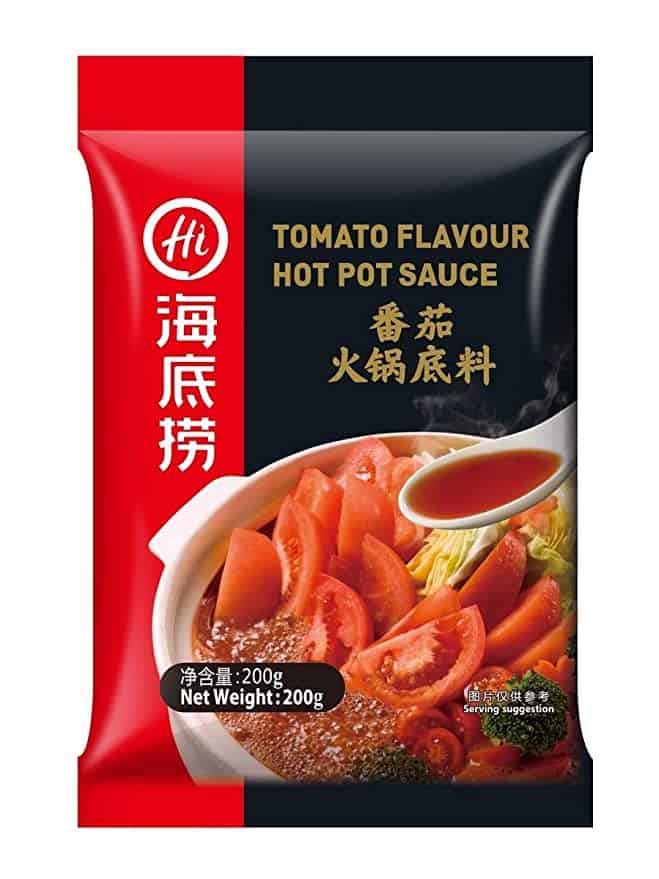
Haidilao Hot Pot Soup – Tomato Flavor
This is a very popular soup base in the Haidilao Hot Pot restaurant. It is a crowd-pleaser that brings the vibrant flavors of fresh tomatoes to your hot pot.
Known for its exquisite balance of tangy and sweet, this soup base is a top-notch choice that elevates any hot pot experience. It’s easy to use, comes in paste form to put directly into the water, saving you time and effort, and consistently delivers that classic, comforting taste of ripe tomatoes, accentuated with a subtle hint of spices.
Perfect for both meat lovers and vegetarians alike, the Haidilao Tomato Soup Base is a versatile option that complements a wide array of hot pot ingredients. Give it a try and bring home the Haidilao hot pot experience you know and love.

Little Sheep Hot Pot Soup, Original & Spicy
Experience the irresistible taste of Little Sheep Original and Spicy Soup Base, a perfect blend of tradition and spice that sets the stage for an unforgettable hot pot feast.
The Original soup base offers a classic, rich, and savory flavor that pairs beautifully with any ingredient, providing a comforting foundation for your meal.
On the other hand, the Spicy soup base packs a punch, delivering a delightful heat that spicy food enthusiasts will adore.
Each base is crafted using high-quality ingredients, ensuring a depth of flavor that enhances your hot pot experience. Whether you’re craving a traditional hot pot or something with a bit of kick, Little Sheep Soup Bases are sure to impress. Enjoy the convenience of a ready-made base without compromising on taste.
NOTE: Check out this post for more recommendations on Top Picks for Best Hot Pot Soup Base.
2. Selecting Meats, Seafood, Vegetables, and More
Choosing the right meats and vegetables for your hot pot is key to creating a delicious and satisfying meal. We will provide you with a checklist of the best cuts of meat, fresh vegetables, seafood, and more for your hot pot. These ingredients will needs to be wash and cut into appropriate sizes during preparation stage.
Top 10 Meat Options
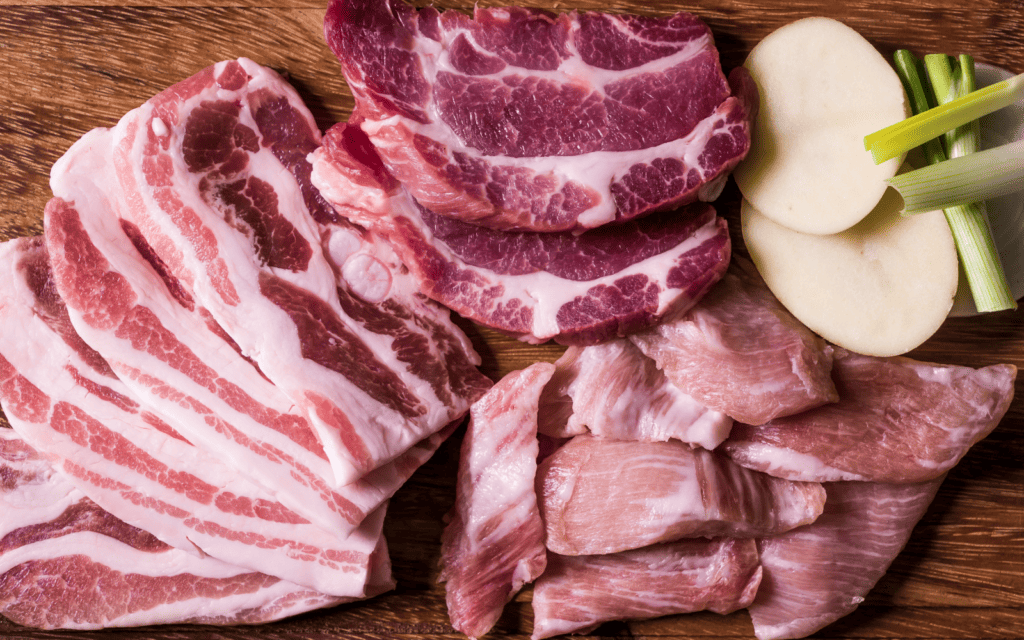
In the art of hot pot preparation, the meat is traditionally sliced very thin and kept semi-frozen. This method serves several crucial purposes.
Thinly sliced meat not only cooks rapidly in the hot broth but also soaks up the flavors of the soup base, resulting in a tender, flavorful bite every time. The semi-frozen state of the meat aids in achieving these thin, uniform slices. It gives the meat firmness, making it easier to cut precisely without tearing or damaging the meat.
- Beef Ribeye: Tender and marbled, ribeye offers a rich flavor that’s perfect for hot pot.
- Beef Brisket: Slightly tougher but full of flavor, brisket becomes tender and juicy when cooked in the hot pot.
- Lamb Shoulder: With a good balance of fat and lean meat, lamb shoulder adds a distinct, delicious taste to your hot pot.
- Pork Belly: This fatty cut is a hot pot favorite, delivering a melt-in-your-mouth texture when cooked.
- Chicken Thigh: More flavorful than breast meat, chicken thighs become succulent and tender in the hot pot.
- Pork Collar: Known for its marbling, pork collar provides a blend of textures and flavors.
- Beef Tenderloin: As the name suggests, tenderloin is incredibly tender and lean, making it a premium choice.
- Lamb Loin: Tender and mildly flavored, lamb loin is an excellent choice for those looking to add variety to their hot pot.
- Duck Breast: With its rich flavor and layer of fat, duck breast brings a unique taste to the hot pot.
- Veal Shoulder: Tender and mild in flavor, veal shoulder is an excellent option for those seeking a lighter meat option.
Top 10 Vegetable Options

The use of fresh vegetables not only introduces a vibrant array of colors and textures to your meal but also contributes significantly to the overall flavor and nutritional content.
- Napa Cabbage: Known for its tender leaves and sweet flavor, Napa cabbage is a staple in many hot pot meals.
- Bok Choy: This leafy green offers a mild, slightly sweet taste and crisp texture that stands up well in the hot broth.
- Spinach: With its tender leaves and high nutrient content, spinach adds color and health benefits to your hot pot.
- Mushrooms: Varieties such as Shiitake, Enoki, and Oyster mushrooms add a delicious umami flavor and a variety of textures.
- Bell Peppers: Their crisp texture and vibrant colors add visual appeal and a sweet, mild flavor.
- Carrots: Sliced thin, they cook quickly and bring a touch of natural sweetness to the hot pot.
- Broccoli: With its firm texture and mild flavor, broccoli adds a satisfying crunch to your meal.
- Lotus Root: This root vegetable offers a unique, slightly sweet taste and a crunchy texture, making it a delightful addition to any hot pot.
- Corn: Kernels or small cob sections can add a touch of natural sweetness to balance the savory broth.
- Daikon Radish: Thin slices of this mildly flavored radish can absorb the flavorful broth, providing a delicious, tender bite.
Top 10 Seafood Options

These seafood choices can add a fantastic variety of flavors and textures to your hot pot, making your meal even more of a delight for seafood lovers. Cooking seafood in the hot pot makes the soup super flavorful.
- Shrimp: With its sweet flavor and firm texture, shrimp is a classic choice for hot pot.
- Scallops: These tender, sweet morsels bring a touch of luxury to your meal.
- Squid: Sliced into thin rings, squid cooks quickly and adds an enjoyable chewiness.
- Fish Fillets: Thin slices of mild white fish like tilapia or cod can be poached to perfection in the hot broth.
- Mussels: These shellfish add a distinct, savory ocean flavor to your hot pot.
- Crab Legs: Adding crab legs to your hot pot can turn it into a truly special occasion meal.
- Clams: Small clams can be cooked whole, and they’ll open up when done, adding their juices to the broth.
- Lobster Tail: Cut into large chunks, lobster tail brings a succulent, sweet flavor.
- Octopus: Pre-cooked octopus can be sliced thin and added to the hot pot for a unique texture and taste.
- Oysters: Fresh oysters add a distinct briny flavor that seafood lovers will appreciate.
Top 10 Other Options

These extras not only add variety and depth to your hot pot but also allow you to customize the dish to cater to different tastes and dietary preferences.
- Fish Cakes or Fish Balls: Pre-cooked and slightly springy, they add a different flavor and texture profile.
- Tofu: Soft, firm, frozen, or fried, tofu absorbs the flavors of the broth and adds a delicious texture.
- Noodles: From udon to glass noodles, they provide substance and can soak up the flavorful broth.
- Dumplings: These delicious parcels can contain a variety of fillings, from shrimp to pork, and cook perfectly in the hot pot.
- Meatballs: Whether they’re made from beef, pork, or chicken, meatballs add a satisfying bite to the meal.
- Quail Eggs: These small eggs cook quickly and offer a delightful, creamy texture.
- Seaweed: Varieties like wakame and nori add a unique flavor and are packed with nutrients.
- Rice Cakes: These chewy, neutral-tasting cakes soak up the flavors of the broth beautifully.
- Tempeh: This fermented soy product is a fantastic protein-rich addition for vegetarians and vegans.
- Bean Sprouts: With their crunchy texture and mild flavor, bean sprouts add freshness to the hot pot.
NOTE: Most Asian supermarkets have pre-packaged frozen pre-sliced meat, fresh vegetable platters, and fish balls variety packs to make your life easier!
3. Dipping Sauces for Hot Pot at Home
Dipping sauces are an essential part of the hot pot experience. By combining different ingredients, you can create a multitude of unique dipping sauces that enhance the flavors of your hot pot ingredients. The perfect dipping sauce can take your hot pot experience from good to unforgettable.
Top 10 Dipping Sauce Ingredient Options
- Soy Sauce: This essential ingredient provides a salty, umami base for many dipping sauces.
- Sa Cha Sauce: It is a savory and slightly spicy sauce, characterized by a complex flavor profile that is simultaneously nutty, spicy, and umami-rich. Look for the info below.
- Oyster Sauce: This gives your dipping sauce a savory, slightly sweet, and earthy flavor.
- Sesame Oil: Adds a rich, nutty flavor that pairs excellently with a wide variety of ingredients.
- Chili Oil: For those who like heat, chili oil brings a spicy kick to your dipping sauce.
- Garlic: Minced or grated, garlic adds a robust, savory punch to any sauce.
- Scallions: Chopped scallions contribute a mild, onion-like flavor and a touch of freshness.
- Peanut or Sesame Sauce: This provides a creamy, nutty component that is particularly great for meat and vegetables.
- Vinegar: Rice vinegar or black vinegar can balance the rich flavors with its tangy taste.
- Hoisin Sauce: Adds a sweet and slightly tangy flavor, often used in combination with other ingredients.

Bullhead Sa Cha (Barbecue) Sauce
Sa Cha Sauce is made from a blend of soybean oil, garlic, shallots, chilies, brill fish, and dried shrimp. The result is a thick, aromatic paste that adds a unique depth of flavor to any dish it graces.
The richness of Sha Cha Sauce makes it a perfect pairing for meat, seafood, and vegetables, enhancing their natural flavors.
NOTE: Most Asian supermarkets have pre-packaged dipping sauce for your convenience! Here are some recommendations.
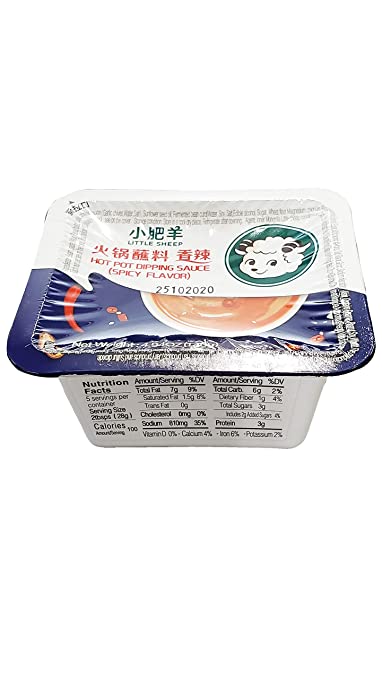
Little Sheep Hot Pot Dipping Sauce
This is one of the best pre-made dipping sauces I have found. It is seasoned just right!
It is a delightful mix of flavors, expertly blended to enhance your hot pot ingredients, ensuring an authentic and hassle-free hot pot experience at home.
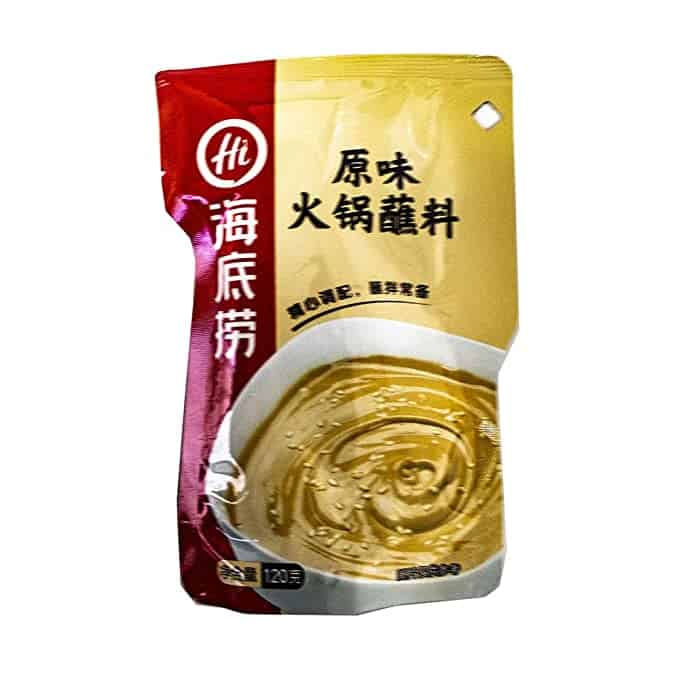
Haidilao Hot Pot Dipping Sauce
This is also a very popular choice of pre-made dipping sauce. It is peanut sauce-based and seasoned just right!
Haidilao Dipping Sauce brings the renowned flavor of the Haidilao hot pot restaurants into your kitchen, delivering a harmonious balance of taste that adds depth and complexity to your hot pot meal.
Cooking and Serving the Hot Pot
Once you have all your ingredients and broth prepared, it’s time to start cooking and serving the hot pot.
For thinly sliced meats (which could be cooked directly from frozen), immerse them into the boiling broth using chopsticks or a mesh strainer, and let them cook for about 5-10 seconds, depending on your preference for doneness. Do not overcook, once it turns brown, it’s ready to eat.
Vegetables take a bit longer; tougher ones like radishes and pumpkins might need up to 5 minutes, while leafy greens like bok choy or spinach only need about 30-60 seconds.
Seafood varies, with shrimp and thinly sliced fish cooking in about 1-2 minutes, and shellfish like mussels and clams ready once their shells open.
Extras such as fish balls and dumplings are done cooking when it floats to the top of the pot. Tofu or noodles should be submerged in the broth and cooked according to package instructions, typically for a few minutes. Remember, hot pot is about enjoying the process of cooking and eating together, so take your time, try different combinations, and adjust cooking times to your taste.
PRO TIP: Meal prep ingredients into individual portions and freeze them for a quick lunch!
Clean Up
Since hot pot involves very hot liquid, use extreme caution during the clean up. Please keep these in mind:
- Be sure to turn off the heat source. Unplug from the power outlet or eject the gas can.
- Wait for it to cool down. Do not rush this process.
- Consider straining the solids from the soup before discarding the liquid.
Conclusion
Creating a hot pot at home is an engaging culinary journey, filled with a diverse array of flavors and textures. Start making plans with friends and family to have a hot pot party soon. We hope you enjoy our guide to having a delicious hot pot meal at home!
Frequently Asked Questions (FAQs)
Is hot pot healthy?
Hot pot can indeed be a healthy meal option, as it primarily consists of broth-based cooking of various fresh ingredients such as lean meats, seafood, and an array of vegetables. Its health factor largely depends on the ingredients you choose and the broth used. Opting for low-sodium broth, lean meats, and an abundance of vegetables can make hot pot a nutritious, balanced meal.
What kind of meat is best for hot pot?
The best kind of meat for hot pot is usually thinly sliced beef or lamb due to their tenderness and quick cooking time. However, variety is key, and incorporating different types like pork, chicken, and a range of seafood can enrich the hot pot experience. Remember that the meat’s freshness and quality significantly influence the taste, so choose high-quality cuts whenever possible.
Can I use a regular pot to make hot pot?
Yes, you can use a regular pot to make hot pot. However, a specialized hot pot with a divider is often preferred as it allows you to cook two different flavors of broth at the same time. Regardless, the key is to choose a pot that’s wide and shallow enough for all ingredients to be spread out and cooked evenly.
How do I know when the hot pot is ready to eat?
Hot pot is ready to eat when the broth has come to a rolling boil and you’ve added your chosen ingredients. Meats and seafood cook quite quickly, usually within a couple of minutes, while vegetables may take a bit longer depending on their type. Remember, hot pot is designed to be a communal, cook-as-you-eat experience, so ingredients are often added gradually and eaten as they are cooked to the desired level of doneness.
Can I make hot pot without meat?
Absolutely, you can make a hot pot without meat. There are plenty of delicious vegetarian and vegan options available for a hot pot, including a variety of vegetables, tofu, tomato, mushrooms, and plant-based meat substitutes. It’s all about selecting ingredients you enjoy and ensuring a flavorful broth to create a satisfying meat-free hot pot.
If you plan to hot pot at a restaurant, we recommend checking out Haidilao.

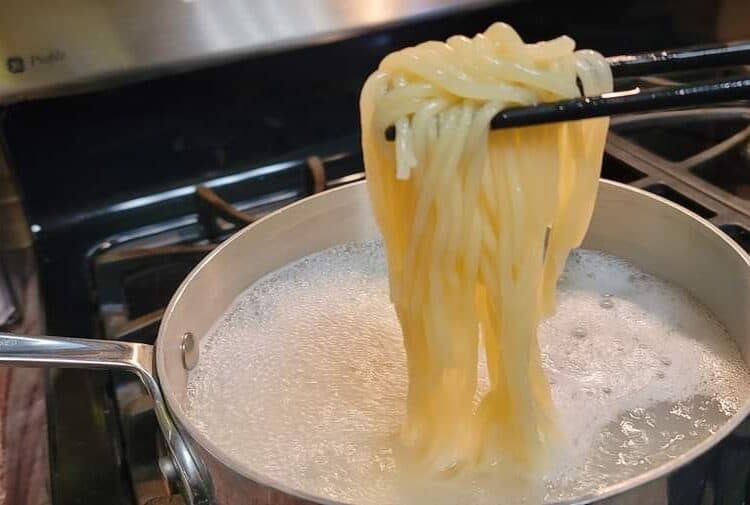



Never heard of hot pot. This was very interesting to read!
Definitely give it a try if you have a chance. You’ll find it’s a super easy meal to even feed a crowd!
I’ve never heard of this! Can’t wait to try.
I’m glad it peaked your interest! Trust me, it’s super easy meal!
I’ve heard of a hot pot – but never tried it (especially at home!) I’m really inspired to give it a try after reading your great tips and the ultimate guide to hot pot at home is perfect and easy to follow! Thank you for sharing!
I learned something today! I’ve never heard of this before but it looks super fun and yummy!
This is so timely! I was watching a Chinese drama the other night and they were making a hot pot and I thought it looked so delicious and comforting, so I thought I’d try making one, but didn’t know how to start… So thank you for this! I also like that you make it easier for us to try this. Definitely trying this out soon.
Definitely give it a try, enjoy!!
omg i love a good hot pot! thanks for these tips!
You’re very welcome, give it a try and enjoy!
I have always wanted to have a hot pot party and this post has explained things so well. I have most of the things needed ao now all i need is to fix a date and call people over.